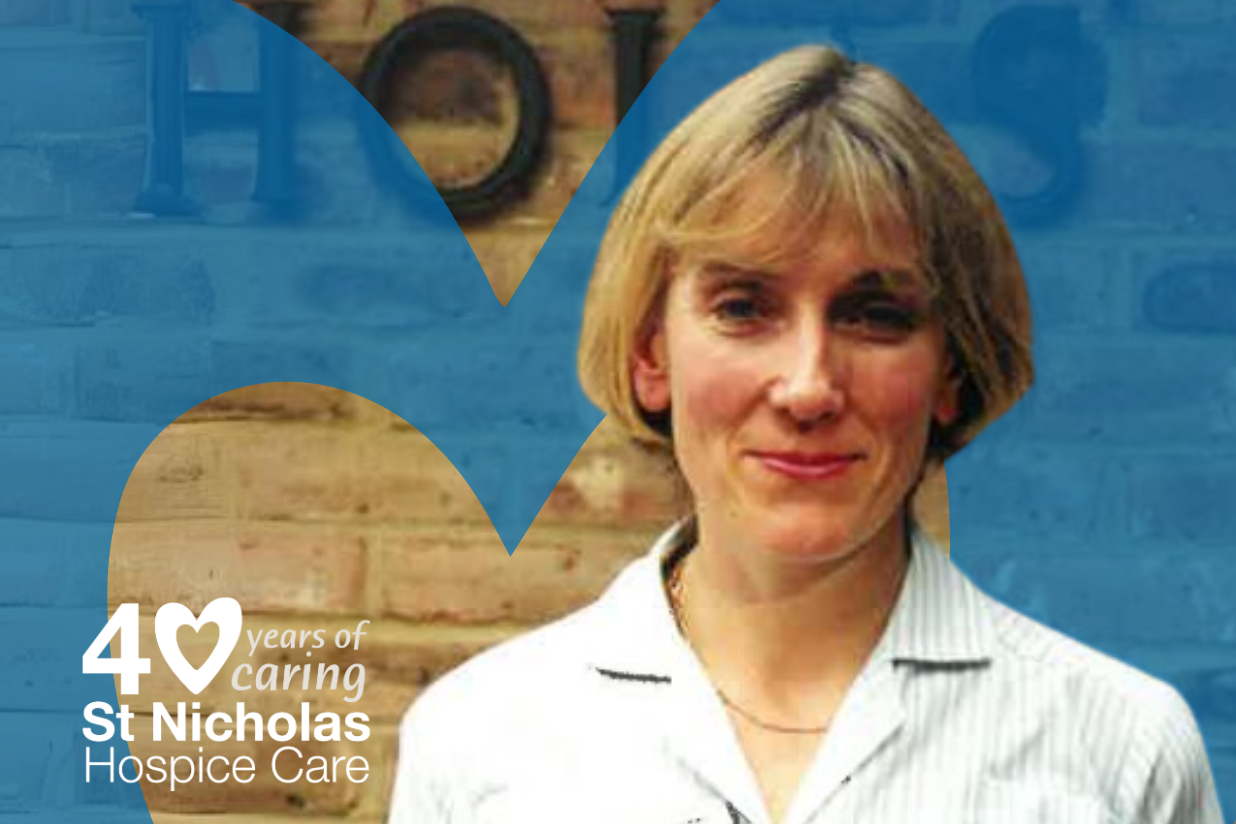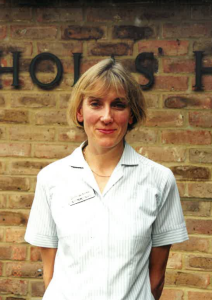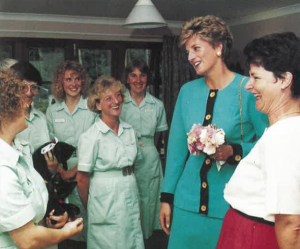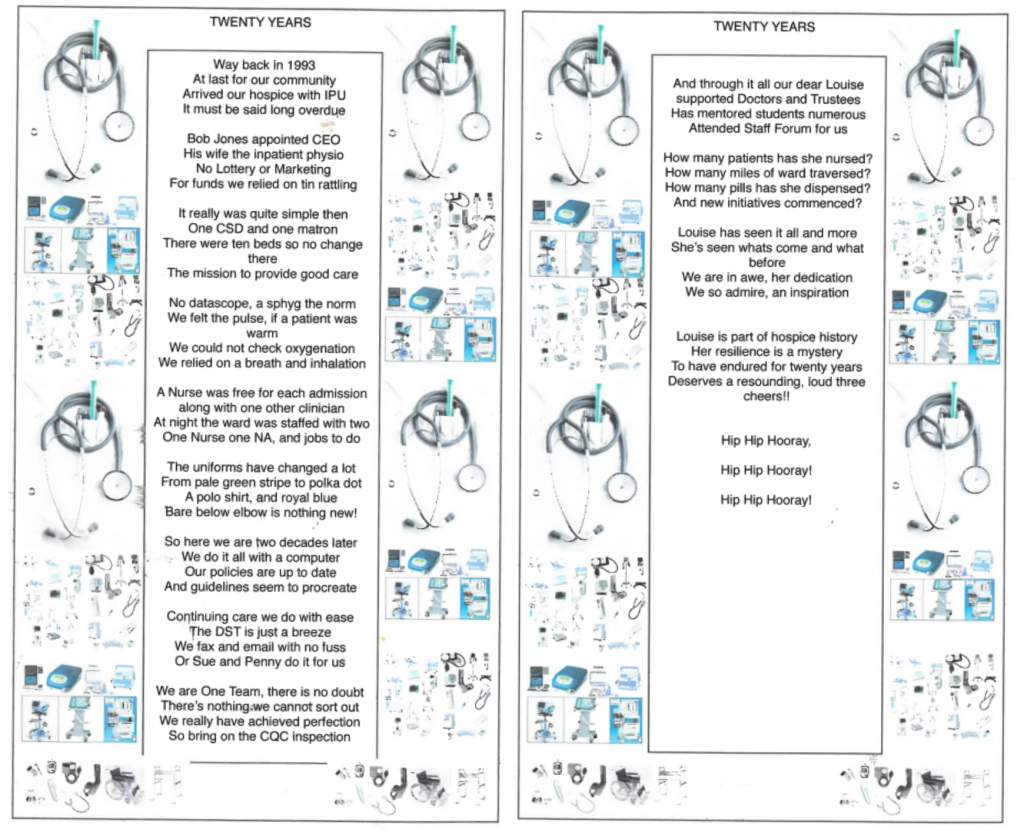Call our 24/7 advice line for health care professionals and families if you need support with symptom management and end of life care - 01284 766133.

Louise Whitehead
I experienced the loss of my father to cancer when I was 12-years-old. This had an impact on me as when I decided to do my nurse training I was somehow drawn to patients with cancer.
This was because I wanted to do as much for them as possible to ensure their comfort as I had felt at a loss as to how to do this for my father when he was ill.
I was drawn into hospice care as I became aware that I liked to have time to spend with patients and be able to provide individualised care rather than the mad rush that it had become in the main hospital on a busy medical ward.
My heart was always on the ward


I arrived at St Nicholas Hospice on March 15 1993, which was the official start date for all the new staff. We had a week’s induction before admitting our first patient.
My role was as a registered nurse aka R/N. I continued as a clinically based nurse as I have always preferred to be involved in direct patient care rather than in a management role. I did at one time consider working in the community team and spent several placements with this team over the years but realised that my heart was always on the ward.
I applied for the role as a hospice nurse as had always had an interest in hospice care. It was when I saw advertisements for nurses at St Nicholas Hospice, which was shortly to open that I jumped at the opportunity and was lucky enough to be offered a post.
This caring culture has continued
When I first started at the hospice in 1993 it was like a family as everyone was new to palliative care apart from the four Macmillan nurses as they were then known. We all felt quite nervous and inexperienced and so offered mutual support. This caring culture has continued.
There were about 20 nurses initially with much the same on a shift as today except that in the early days there were three RNs and one healthcare assistant on a shift rather than two of each. The RN’s were in those days more involved in direct patient care, there being much less paperwork and medications less complex.
In 1993 the Hospice was a much smaller organisation with only four Macmillan nurses. There was always a day care unit as this was from transferred form Turret Close where the Hospice first originated in Bury St Edmunds.
At that time all the staff across the whole organisation knew each other and the four members of the “mac” team would come to the ward for coffee and cake every Friday morning. We learnt a lot from those four as they had all had previous palliative care experience.
Cats slept on patient’s beds and offered comfort to cat lovers
The field of hospice care has expanded hugely over the years both nationally and locally. The hospice movement originated in 1969 with Dame Cecily Saunders but since then palliative care has expanded to include dementia patients and those who are nearing end of life with various different illnesses such as heart failure, Parkinson’s and neurological conditions that are progressive.
In the early days, the Hospice had regular respite care patients particularly those with MS or MND. These patients we got to know very well as they were “regulars”.
The Orchard Day Therapy made remarkable progression over the years in offering not only day care support but provided many other support groups for both patients and carers.
The Family Support Team (now Psychological Services Team) consisted of one member with volunteer bereavement support workers to care for patients and families. This has also expanded vastly over the years with many more referrals being made.
There was also only one chaplain in the early years whereas there is now a large team of volunteers under Sharon offering pastoral care.
It is impossible to list all the changes I have witnessed as there are so many.
One I do recall with affection was the two hospice cats that were very part of the team.
They were small kittens when they arrived, named Dex and Morph after two commonly used drugs! These cats slept on patient’s beds and offered comfort to cat lovers. They also found cosy spots to sleep in the linen cupboard etc. The empty beds has special covers as protection from cat hairs… so much choice in places to sleep.
Overall there were less restrictions as Health and safety currently imposes many more both locally and nationally.
A privilege to work here
I think I have stayed here so long as found that palliative care is my “niche”. I feel it is a privilege to work here as it is a rewarding and gratifying role as well as varied.
Both patients and families are so grateful for the care they receive which makes the role as a nurse so worthwhile.

Although the team has had its ups and downs it is a happy supportive team that experiences both tears and laughter. I also consider my colleagues to be my friends.
The aspect of my job that I find fulfilling is being able to connect with people and convey care and compassion.
This is because we have the luxury of spending time with patients and families so that care can be individualised.
“Boogying on down” with a patient
Over the years I have learnt the importance of living life to the full and living in the moment, I feel blessed to have had good health myself. I feel that material things are less important than friendships and experiences.
There have been very many extra things that we as a team have been able to do with patients. There have been weddings, parties and significant outings. One that sticks in my mind was taking a lady to the bluebell woods in Polstead as this was her dying wish.
Another occasion was “boogying on down” with a patient in the bathroom with music, candle light and lots of bubbles (in the bath!!) This certainly helped her anxiety and brought a smile to her face.
The carriage was a commode
One of my memorable moments was the pantomime “Cinderellie “produced and performed by Hospice staff from all departments including the then CEO Bob Jones who was Baroness Wage Packet. He was of course in drag!
I was the most alarmingly charming Prince Charming and Cinderellie was a member of staff named Ellie. The carriage was a commode and so on and so forth.
Many quips were made, which were in-house jokes, so it involved the whole Hospice. It was fun and the audience involved patients, families and friends. It was a huge success and provided much laughter.
We had yearly Hospice fetes, which were in those days, the main fundraiser. An amusing incident was at one such fete the Chaplain’s bike which he had parked by the entrance was inadvertently sold for a fiver.
People feel safe here
I find it hard to pick three words to describe St Nicholas because it is a unique and special place.
However the comments often made by visitors and patients alike are that they are amazed that it has a happy atmosphere, whereas they expected to find sadness. Of course, there are very sad times but a lot of happiness too.
The Hospice is often described as serene and peaceful, and people feel safe here. I think we all feel those are such valuable attributes that the Hospice affords.
Thoughts on the future
My thoughts on the future of Hospice care is that it should extend further into caring for people in their own homes, but at the same time, the ward is invaluable when there is not the appropriate support available.
I would like to see Day Therapy reinstated as this was an important adjunct to hospice care. It would enable earlier discharges from the ward by providing the continued connection to the Hospice.
I feel it would be beneficial to have a closer liaison with the Trustees to validate their role in the provision of services and to enable staff to be aware of future plans.
There used to be an active in-house education programme with weekly speakers, seminars and conferences which was open to Hospice staff, GPs and district nurses, etc. This was an excellent opportunity to increase knowledge and keep up to date with advances in palliative care.
The advice I would give to aspiring hospice nurses is that it is a very special place to work. However, it can be that their own personal experiences can affect how they are able to manage caring for patients reaching the end of their life.
Do you have a story about your connection with St Nicholas Hospice Care?
In our 40th year celebration, we want to highlight the many contributions in our Hospice’s history.
We’re aiming to proudly feature 40 faces across the year, could you be someone who has a story to share?
If you are someone who has a fond memory to share, you can do so here.
